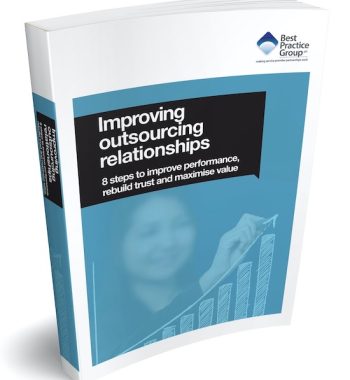 We have come a very long way since the early days of the Business Process Outsourcing (BPO) market, but how much:
We have come a very long way since the early days of the Business Process Outsourcing (BPO) market, but how much:
- has really changed for the better; and
- conversely, have ‘improvements’ been seen to have, in reality, just papered over the cracks?
In our last article in this series How outsourcing has evolved over the last 20-years, we investigated the rise of the early stages of IT outsourcing (from Kodak onwards) through the decades in which the concept of outsourcing and the client environment it served, have changed significantly. The expectations this new era created, and the reality that followed, were discussed, and the dawn of automation with its potential for a new golden age in outsourcing brought us to the present, and maybe a little insight into the future as well.
So, where are we today? What is the current state of play in the Business Process Outsourcing market?
What looks positive in the current Business Process Outsourcing market environment:
Significant advances have been made in the BPO world. Technologies have improved to such an extent that the capability to provide, and subsequent demand to receive, 24/7 services has become a ‘norm’. An ever-increasing portfolio of joined-up services and data to optimise these services has led to a major shift in offerings from, and expectations of, strategic suppliers.
- More strategic BPO services are maturing. Most strategic suppliers today look to sell the perception of higher value-added services to their clients. These include such services as financial and market research, credit rating, customer analytics, cybersecurity, automated data processing and so forth.The current global business ecosystem, in terms of outsourcing, can now provide round-the-clock – twenty-four hour, seven days per week, three hundred and sixty-five days per year – customer service and IT support, and extremely cost-effective ways to manage global supply chains, payroll processes, manufacturing, or access to global talent and knowledge.This perception of a strategic supplier ‘one-stop-shop’ has gained traction with clients, attracted by the convenience offered by a supplier promising to combine strategic and tactical competencies that create greater value by assimilating disparate products and services across the client organisation.
- Everything-as-a-service. This combining of more strategic BPO services and the ever-increasing capabilities of cloud-based solutions, is moving the market into an ‘Everything-as-a-Service’ model. Growing numbers of strategic suppliers are moving to working in high collaboration/productivity environments with clients in piloting to innovate new ways to improve effectiveness in their BAU operations.This piloting model is usually employed to test how to reduce day to day BAU transaction costs, while also innovating new service ideas. Combined, this generates a win-win – expanding the strategic supplier’s service portfolio while also helping to improve service effectiveness through clients being able to achieve their organisational outcomes faster as a result.
- Data driven insights. As ‘big data’ has become an industry-wide by-word, suppliers have become accustomed to using the service performance data gathered in increasingly informed ways, meaning that data-driven insights are becoming a key driver of BAU effectiveness. The spin-off benefit is that as BAU services improve, it inspires piloting into other service areas that the data can provide greater insights into.
What is still happening in reality:
As is always the case, change brings with it challenges. The foundation of any collaborative client-supplier relationship is a clear understanding of end goals, but it seems that the market has not matured to a degree where this is calculated and articulated clearly enough, often enough. Contract terms are still often drafted with too little consideration for the development of a trusting collaborative relationship. And the in-house client skills required to maintain the relationship and manage the risks, in a number of cases, are still lacking. All of which leads to too much fuzzy thinking which increases costs and the chances of not achieving the expectations everyone had at the outset. Sometimes, too many times, leading to outright failures.
- Outcomes are still challenging to quantify. Many clients continue to find it difficult to quantify, with enough clarity and in enough detail, the business outcomes they require from their strategic outsourcing supplier for it to understand (a) what to deliver, (b) how to make appropriate profit from these services and (c) how commercially ‘risky’ it would be for the client if it continues to be unable to clarify its expectations to the supplier. Fortunately, over the years, BPG has developed a process for helping clients quantify their business outcomes in a way that suppliers can clearly understand, recognising what they have to do to both deliver on client expectations and maximise return on investment for them.
- Suppliers still charge an ‘ambiguity pricing premium’. In view of this lack of clarity, some suppliers remain nervous of the potential for disputes that may arise because of the inherent ambiguity that exists where (a) the client is unable to clearly articulate and quantify its expectations and/or (b) the supplier itself seems unable to ‘ask the right questions’ of the client so it can help the client through that journey of articulation. Often, suppliers’ will respond with increased pricing premiums to cover for any misunderstandings through the implementation process that may arise over client expectations. However, when clients are able to clearly articulate their expectations, or the suppliers are able to work out what the ‘right questions’ are to ask of the client to get that clarification, suppliers are provided with greater peace of mind. They therefore are able to view clients as ‘mature’ and usually respond with significantly reduced key pricing premiums, confident in the knowledge that these clients have a clearer view of the expectations and performance their supplier will be objectively measured against.
- Strategic supplier relationships still have a high failure rate. Depending upon the source of the data (examples including including Gartner Group and Standish Group) or our own evidence base across 530 strategic relationships, anywhere between c.56% and c.87% of strategic supplier relationships still fail outright within two years. Fortunately, our process of helping clients quantify and articulate the business outcomes they expect from strategic outsourcing services, means that every strategic supplier relationship that BPG has designed from the outset and supported the governance of in on-going management, has successfully achieved the client’s business outcomes expected of it.
- Contract terms still not driving collaborative behaviours. The majority of written contract terms, in the strategic supplier relationships we have been asked to recover over the years, have been found to be unfit for purpose and therefore ineffective at driving good and productive behaviours between the parties. Far too many written contracts we see are designed around the goal of keeping a supplier in line by using financial penalties to protect against the possibility of suppliers not delivering particular services to a client’s specification. However, given that many client requirements are poorly articulated in the first place, from the perspective of a supplier, the creation of penalties for clear breaches of what can only be described as ‘ambiguous instructions’, (a) creates disputes over what the expectation was in the first place and (b) fails to encourage ‘the right’ delivery (which may not be correctly articulated in any event). Our ‘Expert Witness’ work for the high courts – in giving opinion on what has gone wrong with strategic supplier service/solutions delivery and what could have been done to avoid the problem in the first place – has provided us with a unique insight into how higher courts often interpret contract terms with “Expert/Strategic Suppliers” differently, than the legal teams that drafted them in the first place. We used the lessons learned from those court experiences to develop a five-step process to make sure that contract terms are created to be fair and equitable. We make sure they are fit for purpose to both achieve client outcomes and encourage the ‘right behaviours’ from all parties so that the service delivery drives maximum value for the client and is equitably profitable and cash flow generative for the strategic supplier.
- A continued lack of accountability from suppliers. No matter which strategics you choose to focus on, challenges and failures of strategic supplier relationships remain significantly higher than they should be. Experience tells us that most of those failures are as a result of misaligned expectations over requirements/outcomes between client and supplier. Fortunately, case law over the last few years continues to evolve and there have been a number of cases on “Expert Responsibilities” of strategic suppliers and their “Duty to Warn” their clients. In most cases, it is up to the strategic supplier to clarify and validate a client’s requirements and outcomes from the services provided, if those requirements can be reasonably viewed as ambiguous or unclear. In other words, the supplier has a “Duty to Warn” the client of potential ambiguity in its expectations. If the supplier does not warn the client, and as a result issues occur, then it is usually the responsibility of the supplier to remediate/fix any problems with the service to see the client’s outcomes achieved, at its own cost. Any arguments from the supplier that the client’s requirements were not clear or that the requirements have changed (albeit they may not have changed, they may have just been articulated more clearly over time), will often come down to ‘expert responsibilities’, ‘duty to warn’ and case law.
- Client Function Teams remain under-invested. There remains a lack of understanding about the value of, and return on investment, in an internal client function team. It should have its own domain expertise and be tasked with the role to critical friend challenge the performance of a strategic supplier’s service delivery. Our evidence of these teams shows that, when adequately resourced and funded, they provide an average of 8-11 times returned investment for each client function member employed. The BPG Client Function capability building function helps to assure that your strategic supplier relationship drives maximum value and optimises collaboration and innovation between you and your strategic partner. Some progress has undeniably been made in recent years, and the current state of the BPO market is far more stable and sophisticated than it was. However, there is still a considerable distance to go and improvements to make.
So, what does the future hold for this market? Our final article in this series will look deep into new insights to envisage the answer to the ‘where next’ question – what will become of BPO agreements up for renewal, how might demand change in years to come, what sectors are likely to bloom in their BPO demand and how might improvements be made to ensure market maturity at some point in the future?

